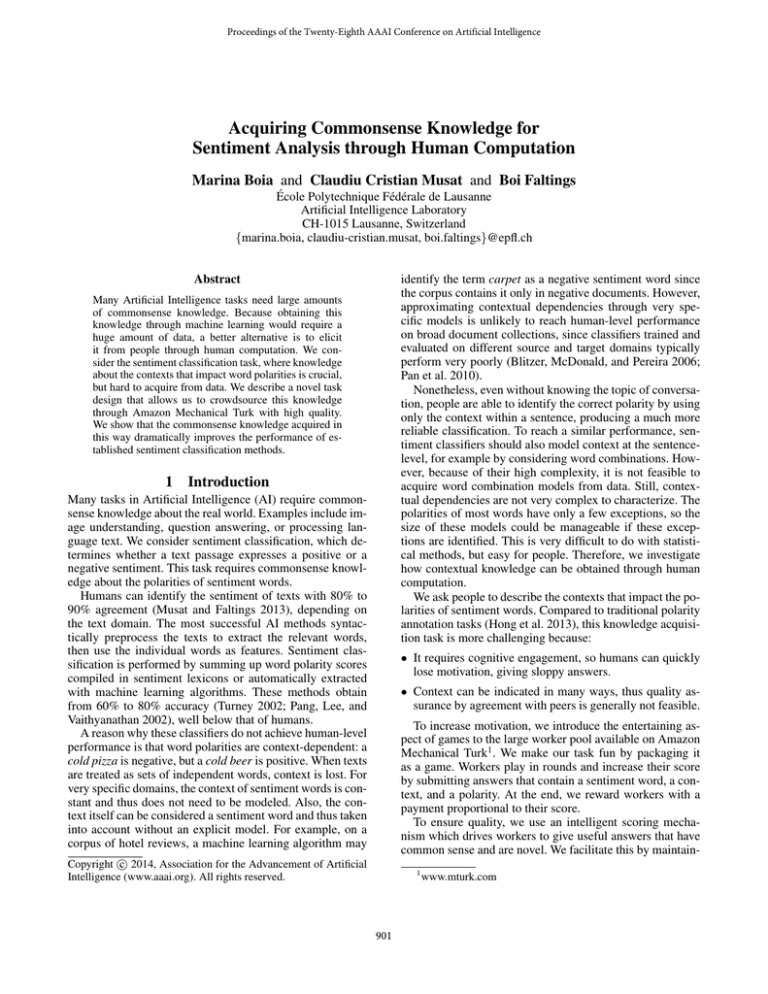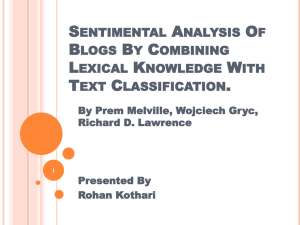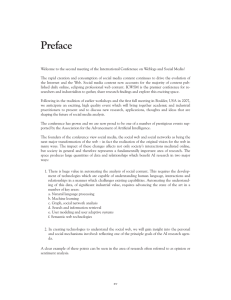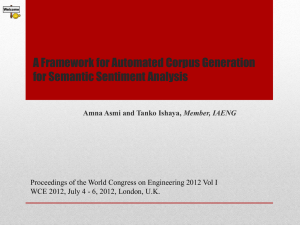
Proceedings of the Twenty-Eighth AAAI Conference on Artificial Intelligence
Acquiring Commonsense Knowledge for
Sentiment Analysis through Human Computation
Marina Boia and Claudiu Cristian Musat and Boi Faltings
École Polytechnique Fédérale de Lausanne
Artificial Intelligence Laboratory
CH-1015 Lausanne, Switzerland
{marina.boia, claudiu-cristian.musat, boi.faltings}@epfl.ch
Abstract
identify the term carpet as a negative sentiment word since
the corpus contains it only in negative documents. However,
approximating contextual dependencies through very specific models is unlikely to reach human-level performance
on broad document collections, since classifiers trained and
evaluated on different source and target domains typically
perform very poorly (Blitzer, McDonald, and Pereira 2006;
Pan et al. 2010).
Nonetheless, even without knowing the topic of conversation, people are able to identify the correct polarity by using
only the context within a sentence, producing a much more
reliable classification. To reach a similar performance, sentiment classifiers should also model context at the sentencelevel, for example by considering word combinations. However, because of their high complexity, it is not feasible to
acquire word combination models from data. Still, contextual dependencies are not very complex to characterize. The
polarities of most words have only a few exceptions, so the
size of these models could be manageable if these exceptions are identified. This is very difficult to do with statistical methods, but easy for people. Therefore, we investigate
how contextual knowledge can be obtained through human
computation.
We ask people to describe the contexts that impact the polarities of sentiment words. Compared to traditional polarity
annotation tasks (Hong et al. 2013), this knowledge acquisition task is more challenging because:
Many Artificial Intelligence tasks need large amounts
of commonsense knowledge. Because obtaining this
knowledge through machine learning would require a
huge amount of data, a better alternative is to elicit
it from people through human computation. We consider the sentiment classification task, where knowledge
about the contexts that impact word polarities is crucial,
but hard to acquire from data. We describe a novel task
design that allows us to crowdsource this knowledge
through Amazon Mechanical Turk with high quality.
We show that the commonsense knowledge acquired in
this way dramatically improves the performance of established sentiment classification methods.
1
Introduction
Many tasks in Artificial Intelligence (AI) require commonsense knowledge about the real world. Examples include image understanding, question answering, or processing language text. We consider sentiment classification, which determines whether a text passage expresses a positive or a
negative sentiment. This task requires commonsense knowledge about the polarities of sentiment words.
Humans can identify the sentiment of texts with 80% to
90% agreement (Musat and Faltings 2013), depending on
the text domain. The most successful AI methods syntactically preprocess the texts to extract the relevant words,
then use the individual words as features. Sentiment classification is performed by summing up word polarity scores
compiled in sentiment lexicons or automatically extracted
with machine learning algorithms. These methods obtain
from 60% to 80% accuracy (Turney 2002; Pang, Lee, and
Vaithyanathan 2002), well below that of humans.
A reason why these classifiers do not achieve human-level
performance is that word polarities are context-dependent: a
cold pizza is negative, but a cold beer is positive. When texts
are treated as sets of independent words, context is lost. For
very specific domains, the context of sentiment words is constant and thus does not need to be modeled. Also, the context itself can be considered a sentiment word and thus taken
into account without an explicit model. For example, on a
corpus of hotel reviews, a machine learning algorithm may
• It requires cognitive engagement, so humans can quickly
lose motivation, giving sloppy answers.
• Context can be indicated in many ways, thus quality assurance by agreement with peers is generally not feasible.
To increase motivation, we introduce the entertaining aspect of games to the large worker pool available on Amazon
Mechanical Turk1 . We make our task fun by packaging it
as a game. Workers play in rounds and increase their score
by submitting answers that contain a sentiment word, a context, and a polarity. At the end, we reward workers with a
payment proportional to their score.
To ensure quality, we use an intelligent scoring mechanism which drives workers to give useful answers that have
common sense and are novel. We facilitate this by maintain-
c 2014, Association for the Advancement of Artificial
Copyright Intelligence (www.aaai.org). All rights reserved.
1
901
www.mturk.com
only a single context. However, when texts come from a
wide range of domains, sentiment words appear in multiple contexts, and accuracy suffers. For instance, classifiers
trained and evaluated on different source and target domains
normally have serious drops in accuracy (Blitzer, McDonald, and Pereira 2006; Pan et al. 2010).
The methods that do model context at the sentence-level
typically extract it from data. (Wilson, Wiebe, and Hoffmann
2005) predicted the polarities of phrases in context with a
machine learning model that used as features the contextindependent polarities of words and the nearby presence
of negations or intensifiers. (Pang, Lee, and Vaithyanathan
2002; Kennedy and Inkpen 2005) trained a sentiment classified model by extending the feature set from individual
words only to also include pairs of words. (Lu et al. 2011)
automatically generated context-dependent lexicons of sentiment words paired with feature nouns. In feature-level sentiment analysis (Hu and Liu 2004), feature nouns serve as
context for sentiment words, but not all methods model how
the polarities of words vary depending on what feature is involved (Lau et al. 2009). Nevertheless, automatically learning contextual variations of word polarities is difficult when
annotated data is limited. We believe context can be more efficiently identified through human computation, and we ask
workers to identify the contexts that influence the polarities
of sentiment words.
The deep learning approach of (Socher et al. 2013) has
a goal similar to ours. They created a sentiment treebank by
asking workers to annotate with polarities all the phrases that
occur in the parsee trees of movie review sentences. They
used this treebank to train a recursive neural tensor network
that learns sentiment compositionality in a semantic vector
space for words. However, this approach does not scale, as it
requires the polarities of 215,154 phrases (each annotated by
three workers) to handle a corpus of only 11,855 sentences.
Moreover, the model that results is completely specific to the
movie reviews and performs poorly on other domains, like
our corpus of vacuum cleaners and digital camera reviews.
By comparison, we ask workers to perform feature selection, and we identify only the relevant word combinations.
Our context-dependent lexicon is smaller and simpler, and
performs well on various domains.
ing a model of word polarities in context, which we initialize from existing sentiment knowledge and refine with the
workers’ input. We reward the answers that agree with and
strengthen this model, which is what we consider commonsensical and novel, respectively. With this interpretation of
useful answers, we successfully create the illusion of a game
played with others.
The output of the game is a context-dependent sentiment lexicon, which we obtain from the workers’ activity on reviews of vacuum cleaners and digital cameras.
On these source domains, our knowledge dramatically outperforms several established context-independent lexicons.
For the best performing lexicon, we increase accuracy with
16.8%. On four target domains, we also substantially surpass a machine learning model and an automatically generated context-dependent lexicon. On book reviews, we top the
former with 12.8% accuracy. On hotel reviews, we surpass
the latter with 22.5% recall.
This paper thus makes three main contributions:
• We are the first ones to obtain high-quality contextual sentiment knowledge using human computation. The resulting knowledge dramatically improves several established
lexicons and surpasses both a machine learning model and
an automatically generated context-dependent lexicon.
• We convert a complex commonsense knowledge acquisition task into a fun game for Amazon Mechanical Turk,
thus motivating workers.
• We develop a scoring mechanism that maintains the illusion of synchronous worker interaction, thus driving
workers to give useful answers.
This paper is structured as follows. Section 2 presents related work. In Section 3 we explain how we represent contextual sentiment knowledge. Next, Sections 4 and 5 describe the game and quality assurance. In Section 6 we explain how we use the context in sentiment classification, and
in Section 7 presents our experiments. Finally, Section 8
draws conclusions.
2
2.1
Related Work
Context in Sentiment Analysis
Sentiment analysis knows two main directions. Lexiconbased methods rely on sentiment lexicons, which enumerate the most common sentiment words and their polarities
(Stone et al. 1966; Wilson et al. 2005; Esuli and Sebastiani 2006; Hu and Liu 2004). A main source of errors is
that sentiment lexicons contain the most common polarities
of words, overlooking the fact that these may be contextdependent.
Corpus-based methods automatically extract sentiment
words and polarities from text corpora. This is typically done
by applying supervised machine learning algorithms to annotated datasets (Pang, Lee, and Vaithyanathan 2002), or by
aggregating syntactic and semantic relations between words
(Turney 2002; Hatzivassiloglou and McKeown 1997). These
methods do not explicitly model context, but when the texts
target narrow enough domains, the resources learned become domain-specific, with sentiment words that occur in
2.2
Human Computation for Sentiment Analysis
The human computation tasks that created resources for sentiment analysis asked workers to provide only simple annotations. (Brew, Greene, and Cunningham 2010) obtained
training data through a text polarity annotation task, whereas
(Hong et al. 2013) generated a sentiment lexicon through
a vocabulary annotation task. (Al-Subaihin, Al-Khalifa, and
Al-Salman 2011; Musat, Ghasemi, and Faltings 2012) asked
workers to both select sentiment words and annotate them
with polarities. By comparison, we require workers to do a
more complex task, by characterizing the contexts that impact the polarities sentiment words.
The quality of the resources created depend on the workers’ motivation. There are several ways to inspire motivation. Payment is one choice. In online labor markets like
Amazon Mechanical Turk, workers are payed for solving
902
tasks. Another way is through enjoyment. Tasks can be designed as games that reward players with points, reputation,
badges etc (von Ahn and Dabbish 2004; Musat, Ghasemi,
and Faltings 2012). In human computation, the two have
been mutually exclusive so far, and games have not yet taken
advantage of the large worker pools available on crowdsourcing platforms. However, we do not see a conflict between payment and enjoyment. We combine the two and
create a game played for money, like poker or the games
on Swagbucks 2 .
Quality can also be explicitly controlled before, during,
and after workers solve a task. Before a task, workers can
be taught about the desired level of performance with tutorials (Sintsova, Musat, and Pu 2013). During a task, workers
can be grouped in teams and required to agree on the answers they provide (von Ahn and Dabbish 2004), or guided
through an intelligent scoring mechanism. After a task, it
is common to filter or aggregate answers in order to cope
with the irrelevant or malicious ones (Ipeirotis, Provost, and
Wang 2010). We ensure quality using all three measures
3
task where we incentivized colleagues with prizes. Therefore, to ensure participants stay motivated, we make the task
fun by designing it as a game.
4.1
In our task, workers see fragments of text, from which they
construct answers that contain a phrase, a context, and a polarity. To build an answer, workers select phrases and contexts from these texts, then annotate the resulting word constructs with their polarities. For instance, from the text I like
this small camera, it fits in every pocket, workers could construct the answer (small, camera, pos).
To increase motivation, we rely on payment and enjoyment. Through payment, we touch on extrinsic motivation.
Workers receive monetary rewards once they finish the task.
Through enjoyment, we target intrinsic motivation. We entertain workers with point rewards that reflect the value of
their answers. We also introduce riddles that workers gradually solve by submitting answers. By combining payment
and enjoyment, we create a game played for money.
To ensure quality, we use a scoring mechanism that encourages workers to submit useful answers. We judge usefulness with two criteria: whether answers have common
sense and whether they provide new knowledge. We consider an answer commonsensical if it is consistent with the
contextual knowledge acquired in the game up to that point,
meaning that it agrees with the common opinion of many
workers. We consider an answer novel if it greatly impacts
the contextual knowledge in the game, meaning that it is
submitted early on and that it contains an ambiguous phrase
along with a disambiguating context. We compute point rewards that are the sum of an agreement score and a novelty
score (Section 4.3).
Contextual Knowledge Representation
We represent contextual sentiment knowledge using the following concepts:
• A phrase phr is a word construct that can carry sentiment.
• A context con is a word construct in the presence of which
a phrase carries sentiment.
• A polarity pol is the positive pos or negative neg orientation of a word construct’s sentiment.
We distinguish two kinds of phrases. Unambiguous phrases
have the same polarity in every context: excellent is always
positive. Ambiguous phrases have context-dependent polarities: low is positive in the context price, but negative in the
context salary.
Sentiment lexicons are traditionally context-independent.
Given a phrase vocabulary P , they enumerate phrases with
their polarities: L = {(phr, pol) | phr ∈ P, pol ∈
{pos, neg}}. This representation either includes ambiguous phrases without their disambiguating contexts, or omits
them altogether. Instead, we consider a more expressive,
context-dependent representation. Given the phrase and context vocabularies P and C, a context-dependent lexicon adds
contexts that clarify the polarities of ambiguous phrases:
CL = {(phr, con, pol) | phr ∈ P, con ∈ C, pol ∈
{pos, neg}}.
4
4.2
Gameplay
Guesstiment is a round-based game (Figure 1). In a round,
a worker sees a text fragment and constructs an answer in
three steps:
• Step 1: phrase selection, in which she selects a phrase
from the text.
• Step 2: context selection, in which she optionally selects
a context.
• Step 3: polarity annotation, in which she annotates the
phrase and context pair with a polarity.
The worker then submits her answer, receives a point reward, and starts a new round. Through this activity, she
solves riddles that point to animals with interesting behavior, like: These animals taste with their feel with butterfly
as solution. The player’s answers unlock hints for these riddles, shown by gradually uncovering a picture that portrays
the solution (Figure 1).
Human Computation Task
To build context-dependent lexicons, we ask workers to find
the ambiguous phrases and their disambiguating contexts.
This task requires cognitive engagement, as not all phrases
are ambiguous and not all contexts disambiguate. Workers
can thus quickly lose interest, giving sloppy answers. Is is
unclear whether extrinsic motivators alone are enough to
keep workers motivated. In previous experiments, we obtained poor results for a simple review polarity annotation
2
Game Design
4.3
Scoring Mechanism
We reward answers using a scoring model that contains beliefs about the polarities of phrase and context pairs. To
each combination of a phrase phr and context con (possibly
empty: con = nil), this model associates a Beta distribution
www.swagbucks.com
903
Figure 1: The interface of Guesstiment
(Gupta 2011). From this distribution we estimate the probabilities that, in the context con, the phrase phr has positive
and negative polarities, respectively: Pr(pos | phr, con) and
Pr(neg | phr, con). For the word pairs that co-occur in the
sentences of our review corpus T rainvac-cam (Section 7.1),
we initialize the corresponding Beta distributions using corpus statistics and several context-independent sentiment lexicons. We use the difference between a word pairs’ frequencies in positive and negative documents, respectively. When
one of the words in the pair appears in a sentiment lexicon,
we complement the corpus frequencies with that word’s polarity score. We incorporate incoming answers by modifying these distributions through a Bayesian update process.
Therefore, the probabilities Pr(pos | phr, con) and Pr(neg |
phr, con) assimilate the fractions of positive and negative
answers, respectively: (phr, con, pos) and (phr, con, neg).
swer contains an ambiguous phrase and a well-defined context. As an indicator for the phrases’s ambiguity, we use the
model’s uncertainty in the phrase’s out of context polarity. If
con = nil, we set cn := 0. If, however, con 6= nil, we use
the entropy over Pr(pos | phr, nil) to quantify the ambiguity of phr out of context. We obtain cn by linearly mapping
this entropy to [0, cnmax ].
We reward the answer with a total score su := ag + cn.
Because we do not want to encourage only unique answers, we give a bigger importance to agreement by setting
agmax > cnmax . We use agmax := 40 and cnmax := 10.
5
Quality Assurance
We ensure answer quality in three steps: with a tutorial before the game, through the scoring mechanism during the
game, by filtering lazy workers and bad answers after the
game.
The tutorial teaches the rules of the game through text
instructions and interactive quizzes. We start by explaining
the concepts of phrase, context, and polarity. Then, workers
solve quizzes in which they learn to construct answers from
simple text snippets. Finally, we explain the round-based nature of the game, the scoring, and the riddles.
For an answer (phr, con, pol), we compute an agreement
score ag ∈ [0, agmax ] that reflects whether it is commonsensical. We set ag highest if the answer agrees with the
model early in the game, because by doing so it considerably improves the model’s confidence. We set ag lowest
if the answer contradicts the model early in the game, because this way it greatly damages the model’s confidence.
Finally, we assign a medium value to ag when the answer
comes late in the game, because then it has a smaller impact on the model’s confidence. We use the entropy over
Pr(pol | phr, con) to quantify the model’s uncertainty in the
polarity of the phrase and context pair. The answer decreases
entropy if it agrees with the model and vice versa. Moreover,
the answer produces bigger changes in entropy early in the
game. We thus obtain ag by linearly mapping the updates in
entropy to [0, agmax ].
5.1
Worker Filtering
We filter out the lazy workers by measuring their performance using a gold-standard lexicon that we obtain by intersecting several context-independent lexicons. For each
worker, we establish: the number gold of answers that contain a phrase from our gold standard lexicon; and the number goldcorr of answers that contain a phrase from the gold
standard lexicon along with its correct polarity. We consider the worker’s performance is good if gold ≥ 5 and if
goldcorr
gold ≥ 0.8.
For an answer (phr, con, pol), we also compute a context
novelty score cn ∈ [0, cnmax ] that reflects whether the an-
904
the impact of context. For each document, we compute a
sentiment score scr. We label the document as positive if
scr > 0 and as negative if scr < 0. If scr = 0, we do not
assign a label. To compute the score, we split the text into
sentences. For each sentence, we identify the phrases that
are in L or in CL. For every phrase phr that we find:
• We scan a window of seven words centered around it
to identify the contexts con 6= nil for which we have
(phr, con, polCL ) ∈ CL.
• For every (phr, con, polCL ) ∈ CL that we find, we update the score with one unit based on the sign of polCL .
• If we cannot find any (phr, con, polCL ) ∈ CL, we determine if (phr, polL ) ∈ L and if (phr, nil, polCL ) ∈ CL:
– If (phr, polL ) ∈ L, we update the score with one unit
using the context-independent polarity.
– If (phr, polL ) ∈
/ L, but (phr, nil, polCL ) ∈ CL,
we update the score with one unit using the contextdependent polarity
We initially used the method above, but noticed the quality of the remaining answers was still quite low. We thus
assess performance with an alternate method. We define several gold-standard game rounds that we interleave with the
regular rounds. The gold rounds show simple text fragments
with only a few acceptable, gold standard answers. For each
worker, we establish: the number gold of answers she submitted in gold rounds; and the number goldcorr of those answers that belong to our set of acceptable, gold standard answers. We then judge the worker using the same criteria as
for the previous method.
5.2
Answer Filtering
After we eliminate the bad workers, we have the remaining answers: A = {(phr, con, pol) | phr ∈ P, con ∈
C, pol ∈ {pos, neg}}. From these, we derive the aggregate answers: AA = {(phr, con, wkrpos , wkrneg ) |
phr ∈ P, con ∈ C, wkrpos , wkrneg ∈ N}. An aggregate answer (phr, con, wkrpos , wkrneg ) contains a phrase
and context pair, along with the number of workers that
included them in positive and negative answers respectively. We use these aggregate answers to obtain a contextdependent lexicon: CLgame = {(phr, con, pol)}. For each
(phr, con, wkrpos , wkrneg ) ∈ AA, we add (phr, con, pol)
to CLgame : we set pol := pos if wkrpos > wkrneg , and
pol := neg if wkrpos < wkrneg .
From CLgame , we remove the elements that damage
sentiment classification performance. We use a classification method that combines a context-independent lexicon L
with a context-dependent one CL (Section 6). When CL is
empty, the method relies on the lexicon L alone. When CL
is well-defined, the method uses it to enhance L. We apply
the method in these two modes: we first use a lexicon Lbl
alone (Section 7.2), then we combine Lbl with CLgame . We
apply the classification method on the corpus T rainvac-cam .
For each document, three scenarios can happen: CLgame
fixes an error of Lbl , CLgame damages a correct classification of Lbl , or CLgame neither helps nor harms the output
of Lbl . Thus, for each element in CLgame , we maintain improvement and error counts that we increment when the first
or second scenarios occur, respectively. We use these counts
to remove the elements that damage Lbl .
We prune the bad elements in four iterations. In each iteration, we classify documents and compute the improvement and error counts. We then choose a criterion for pruning CLgame . In the first two iterations, we eliminate the
elements with high error counts. We first remove the elements that act as stop words and produce errors in a considerable fraction of the corpus. These elements pollute the
error counts of the other lexicon items they co-occur with.
We use error ≥ 0.00007 × |T rainvac-cam |. We then remove
all elements with error counts above a fixed threshold. We
use error ≥ 20. In the last two iterations, we remove the
elements that harm more than they improve.
6
7
7.1
Experiments and Results
Task Setup
To create the game rounds, we used Amazon3 product reviews for four categories of vacuum cleaners and digital
cameras, respectively. We used the reviews’ numeric ratings
as a gold standard for their sentiment: the ones with high
ratings as positive, and the ones with low ratings as negative. We ensured each product category had equal numbers
of positive and negative reviews, and randomly split the reviews from each category into train and test data, using a
ratio of roughly 2:1. We used the train data T rainvac-cam of
56,000 reviews to obtain two classifiers: a sentiment lexicon and a support vector machine. We applied the two
models on the test data T estvac-cam , and identified roughly
2,000 reviews T estvac-cam
game misclassified by both. We used
T estvac-cam
to
define
text fragments for the game. We then
game
vac-cam
removed T estvac-cam
to obtain a new test
game from T est
vac-cam
set T estgame
of 31,700 texts.
We deployed the game on Amazon Mechanical Turk.
We launched several HITs, mainly using a base payment
of $0.25, approved with the first 100 points earned, and
bonuses established based on game activity: $0.05 for every
additional 100 points earned, and $0.05 for every 500 points
milestone reached. In total, 980 workers played the game.
In a post-game survey, 88% of them indicated they liked the
game. We kept the activity of 640 workers, amounting to
59,400 answers from a total of 78,000. We aggregated these
answers to a lexicon CLgame of 36,300 items, which we
pruned down to 16,600 elements.
7.2
Context Evaluation
We first assessed the performance of our context-dependent
lexicon on the source vacuum and camera domains, using the corpus T estvac-cam
game . As baselines, we took several
context-independent lexicons and a machine learning model.
We used the lexicons: General Inquirer Lgi (Stone et al.
Context Impact
To classify documents, we combine a context-independent
sentiment lexicon L = {(phr, polL )} with a contextdependent one CL = {(phr, con, polCL )}, thus evaluating
3
905
www.amazon.com
On the electronics, services, book, and movie domains,
our lexicon had accuracies of 86.68%, 78.71%, 72.13%,
and 73.96%, respectively (Figure 3). The increase in accuracy relative Lbl was of 15.49%+ , 16.38%+ , 6.78%+ ,
and 9.24%+ , respectively. Moreover, the accuracy boost
with respect to Lsvm was of 5.53%∗7 , 8.03%+ , 12.85%+
and 4.34%+ , respectively. Our contextual knowledge thus
greatly surpassed both the best standard lexicon and the machine learning model we considered.
We also compared our performance on the hotel reviews
with that of (Lu et al. 2011), who automatically generated a
context-dependent lexicon for feature-level sentiment classification on this domain. CLgame gave a precision of 73.98%
and a recall of 100%. Relative to (Lu et al. 2011), who reported a precision and recall of 72.83% and 77.56% respectively, CLgame increased recall by 22.44%. Our contextual
knowledge thus substantially outperformed an automatically
generated context-dependent lexicon in terms of recall.
Figure 2: Performance on source domains
8
Conclusions
For many Artificial Intelligence tasks, the major difficulty
is that they require large amounts of commonsense knowledge. Since people share this knowledge, it could be obtained through human computation.
We are the first ones to consider the acquisition of contextual knowledge for sentiment classification. A big challenge
was keeping workers interested in a complex task that required cognitive engagement. To overcome this, we made
the task enjoyable by designing it as a game. Another obstacle was ensuring answer quality when workers were not
simultaneously present and thus agreement with peers was
not feasible. Instead, we simulated agreement with other
workers by rewarding novel commonsensical answers using
a model derived from the workers’ activity. We thus showed
that human computation makes knowledge acquisition feasible, even when complex actions are required from workers.
From the workers’ activity, we obtained powerful contextual knowledge. On the two source domains for which
we acquired the knowledge, our context-dependent lexicon greatly improved several established sentiment lexicons. On four target domains, we also substantially surpassed a machine learning model and an automatically generated context-dependent lexicon. We thus proved that using
contextual knowledge obtained through human computation
dramatically improves sentiment classification.
In future work, we plan to also improve corpus-based
methods by extending their feature set from individual
words only to also include the contexts that we acquired
through human computation.
Figure 3: Cross-domain performance
1966), OpinionFinder Lof (Wilson et al. 2005), and the lexicon of Bing Liu Lbl . We obtained the statistical model Lsvm
by training a support vector machine on a subset of 2,000
reviews from T rainvac-cam , thus comparable in size with the
corpus in the game (we used a linear kernel and 1,000 unigram presence features). Finally, we evaluated our contextual knowledge CLgame by combining it with Lbl , the best
among the context-independent lexicons. We recorded the
average performance on vacuums, cameras, and overall.
Our lexicon CLgame gave an accuracy of 85.17% (Figure
2). The increase in accuracy relative to Lgi , Lof , and Lbl was
of 24.63%+4 , 19.96%+ , and 16.85%+ , respectively. Moreover, the difference in performance relative to Lsvm was of
-0.78%−5 . Our contextual knowledge thus dramatically improved the standard lexicons and performed as well as the
statistical model trained on these specific domains.
We then assessed the cross-domain performance on four
target domains. We used corpora of: 1,200 Epinions6 electronics reviews (cellular phones and blenders), 12,600 Epinions services reviews (restaurants and hotels), 3,600 Epinions book reviews, and 11,900 Amazon movie reviews. As
baselines, we took Lbl and Lsvm . We evaluated our contextual knowledge CLgame by combining it with Lbl .
References
Al-Subaihin, A.; Al-Khalifa, H.; and Al-Salman, A. 2011.
A proposed sentiment analysis tool for modern arabic using
human-based computing. In Proceedings of the 13th International Conference on Information Integration and WebBased Applications and Services, 543–546.
4
+ statistically significant at the 99% confidence level
− not statistically significant on six out of eight categories
6
www.epinions.com
5
7
906
∗ statistically significant at the 95% confidence level
In Proceedings of the ACL Conference on Empirical Methods in Natural Language Processing, 79–86.
Sintsova, V.; Musat, C. C.; and Pu, P. 2013. Fine-grained
emotion recognition in olympic tweets based on human
computation. In Proceedings of the 4th Workshop on Computational Approaches to Subjectivity, Sentiment and Social
Media Analysis, 12–20.
Socher, R.; Perelygin, A.; Wu, J. Y.; Chuang, J.; Manning,
C. D.; Ng, A. Y.; and Potts, C. 2013. Recursive deep models
for semantic compositionality over a sentiment treebank. In
Proceedings of the ACL Conference on Empirical Methods
in Natural Language Processing, 1631–1642.
Stone, P. J.; Dunphy, D. C.; Smith, M. S.; and Ogilvie, D. M.
1966. The General Inquirer: A Computer Approach to Content Analysis. MIT Press.
Turney, P. D. 2002. Thumbs up or thumbs down?: Semantic
orientation applied to unsupervised classification of reviews.
In Proceedings of the 40th Annual Meeting on Association
for Computational Linguistics, 417–424.
von Ahn, L., and Dabbish, L. 2004. Labeling images with a
computer game. In Proceedings of the SIGCHI Conference
on Human Factors in Computing Systems, 319–326.
Wilson, T.; Hoffmann, P.; Somasundaran, S.; Kessler, J.;
Wiebe, J.; Choi, Y.; Cardie, C.; Riloff, E.; and Patwardhan,
S. 2005. OpinionFinder: A system for subjectivity analysis.
In Proceedings of HLT/EMNLP on Interactive Demonstrations, 34–35.
Wilson, T.; Wiebe, J.; and Hoffmann, P. 2005. Recognizing
contextual polarity in phrase-level sentiment analysis. In
Proceedings of the Conference on Human Language Technology and Empirical Methods in Natural Language Processing, 347–354.
Blitzer, J.; McDonald, R.; and Pereira, F. 2006. Domain
adaptation with structural correspondence learning. In Proceedings of the ACL Conference on Empirical Methods in
Natural Language Processing, 120–128.
Brew, A.; Greene, D.; and Cunningham, P. 2010. Using
crowdsourcing and active learning to track sentiment in online media. In Proceedings of the 19th European Conference
on Artificial Intelligence, 145–150.
Esuli, A., and Sebastiani, F. 2006. SentiWordNet: A publicly available lexical resource for opinion mining. In Proceedings of the 5th Conference on Language Resources and
Evaluation, 417–422.
Gupta, A. K. 2011. Beta distribution. In Lovric, M., ed.,
International Encyclopedia of Statistical Science. Springer
Berlin Heidelberg. 144–145.
Hatzivassiloglou, V., and McKeown, K. R. 1997. Predicting
the semantic orientation of adjectives. In Proceedings of the
35th Annual Meeting of the Association for Computational
Linguistics, 174–181.
Hong, Y.; Kwak, H.; Baek, Y.; and Moon, S. 2013. Tower of
Babel: A crowdsourcing game building sentiment lexicons
for resource-scarce languages. In Proceedings of the 22nd
International Conference on World Wide Web Companion,
549–556.
Hu, M., and Liu, B. 2004. Mining and summarizing customer reviews. In Proceedings of the 10th ACM SIGKDD International Conference on Knowledge Discovery and Data
Mining, 168–177.
Ipeirotis, P. G.; Provost, F.; and Wang, J. 2010. Quality management on Amazon Mechanical Turk. In Proceedings of
the ACM SIGKDD Workshop on Human Computation, 64–
67.
Kennedy, A., and Inkpen, D. 2005. Sentiment classification of movie and product reviews using contextual valence
shifters. Computational Intelligence 110–125.
Lau, R. Y. K.; Lai, C. C. L.; Ma, J.; and Li, Y. 2009. Automatic domain ontology extraction for context-sensitive opinion mining. In Proceedings of the 30th International Conference on Information Systems, 35–53.
Lu, Y.; Castellanos, M.; Dayal, U.; and Zhai, C. 2011. Automatic construction of a context-aware sentiment lexicon:
An optimization approach. In Proceedings of the 20th International Conference on World Wide Web, 347–356.
Musat, C. C., and Faltings, B. 2013. A novel human
computation game for critique aggregation. In AAAI (LateBreaking Developments).
Musat, C. C.; Ghasemi, A.; and Faltings, B. 2012. Sentiment analysis using a novel human computation game. In
Proceedings of the 3rd Workshop on the People’s Web Meets
Natural Language Processing, 1–9.
Pan, S. J.; Ni, X.; Sun, J.-T.; Yang, Q.; and Chen, Z. 2010.
Cross-domain sentiment classification via spectral feature
alignment. In Proceedings of the 19th International Conference on World Wide Web, 751–760.
Pang, B.; Lee, L.; and Vaithyanathan, S. 2002. Thumbs up?:
Sentiment classification using machine learning techniques.
907







